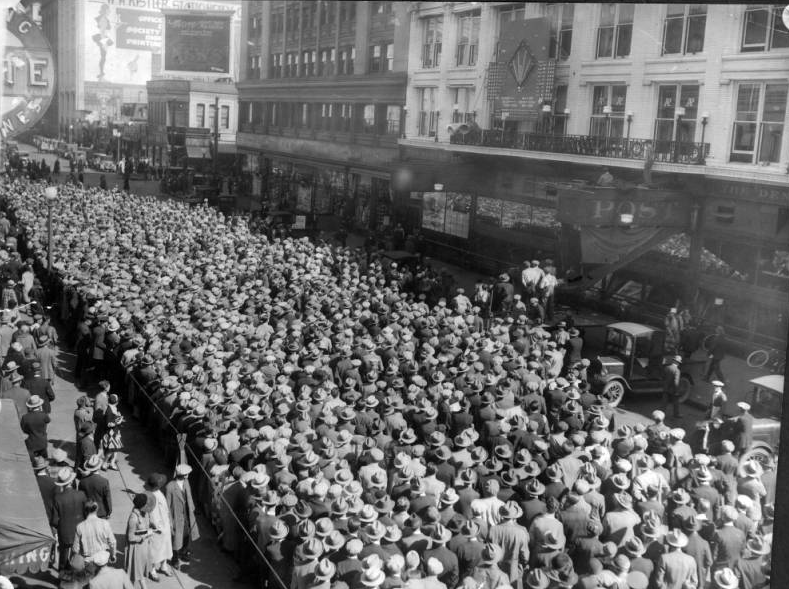In downtown Denver a large crowd assembles on Champa Street by the Denver Post headquarters to follow the first game of the 1927 World Series via an electronic scoreboard. The New York Yankees would defeat the Pittsburgh Pirates 5-4.
It’s hard to tell what version of the electronic scoreboard that is hanging in the side of the building as there was several dozen varieties in use with one of the most popular being the Playograph made in Stamford, Connecticut. The ingenious machine usually relied on two to three operators hidden from the public view, one would get updates of the game from the telegraph and relay them to his co-operator who would move the baseball on the huge billboard-like scoreboard (usually around nine in height) to the delight of the spectators in the front.
It worked the same way as a ESPN GameCast does today with balls and strikes being updated pitch-by-pitch, indicators showing what bases the runners are and so forth. An article that appeared in the September 1912 issue of The Yale Scientific Monthly described in great detail how it worked:
“On a vertical board is painted an exact reproduction of a baseball diamond . At first, second and third bases and at home plate, are slots which appear a cross which signifies that the runner is safe, or an O which donates that the man has been put out. By the audience, a white ball is seen which moves rapidly over the field exactly as in a real game. For instance, the ball remains stationary in the pitcher’s box until the pitcher is ready tp throw it, when it shoots down toward the play, in a straight line, or a curve, as may be desired, If the ball pitched is a ball or a strike, it goes past the home plate to the catcher’s box, and opposite the painted words “Balls” or “Strikes” appears a number telling the number of balls or strikes on the man. If the ball is hit, it shoots out to wherever it is actually hit and in a slot provided for the purpose appears “Fly Ball”, “Fouled Out”, or whatever happened. If the man is safe, in the slots at the bases appears a cross; if put out, a large O. If there is a fumble, a pointer inscribed “Fumble” runs down the lineup of the players which is placed on each side of the field and indicates who made it
In short the Polygraph shows every possible play including Strikes, Balls, Outs, Runs, Single, Two or Three Base Hits, Home Runs, Bunts, Passed Balls, Wild Throws, Muffed Balls, Fumbles, Strike Outs, Bases on Balls, Grounders, Fly Ball, Fouls, Errors, Batting Order, Batter Up, the Inning and the Half-Inning, Score by Innings, Hits, Runs, and Errors of all Individual Players and Bases showing runner Safe, Out, on, or Off Base.”
And these scoreboards were a big hit among baseball fans drawing hundreds if not thousands to them across in country in major cities and even rural areas. On October 15, 1911 the New York Evening Telegram estimated that over 70,000 turned out to watch a Polygraph in action at Herald Square for the 1911 World Series, almost double of the actual crowd at the Polo Grounds who saw the game live. The Telegram’s coverage captured the excitement of the crowd as they watched the board:
“With tense interest that strained all eyes towards the quivering ball in the center of the miniature diamond the crowd caught each ball, each strike and each “out” of the final inning and in the fraction of a second changed from breathless silence into a cheering, shouting, hat-waving, back-slapping throng which swept up and down Broadway with a roar of victory”
And while the Playograph might have been the most popular of these animatronic scoreboards, it was far from the first , as far back as the 1880’s they were in used in one form or another, including in a Augusta, Georgia opera house which used a blackboard and flag’s representing as runners, and like their successors used the telegram to relay the info, all the while charging spectators 10 cents for admission.
But as the years passed, the popularity of the Playograph and its competitors waned as broadcasting games on the radio grew and soon these electronic scoreboards would become obsolete.
-Ron A. Bolton
Photo Source – Denver Public Library
Info Source – https://connecticuthistory.org; The Yale Scientific Monthly(via Paul Lukas); https://www.citylab.com/

